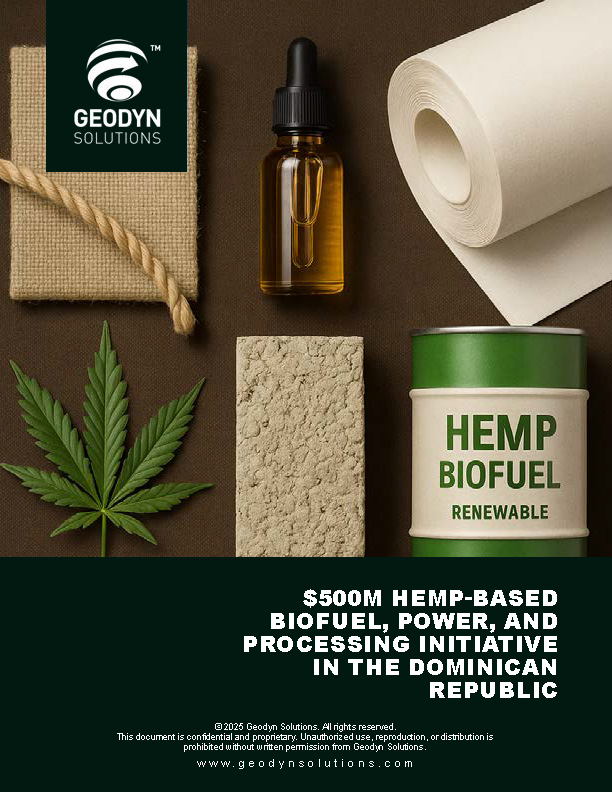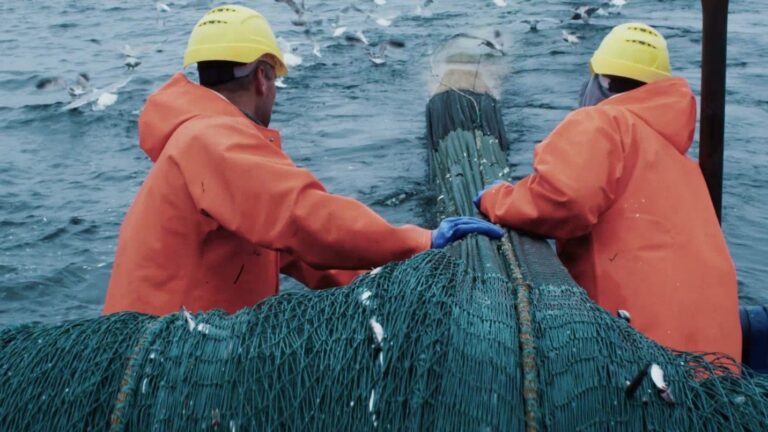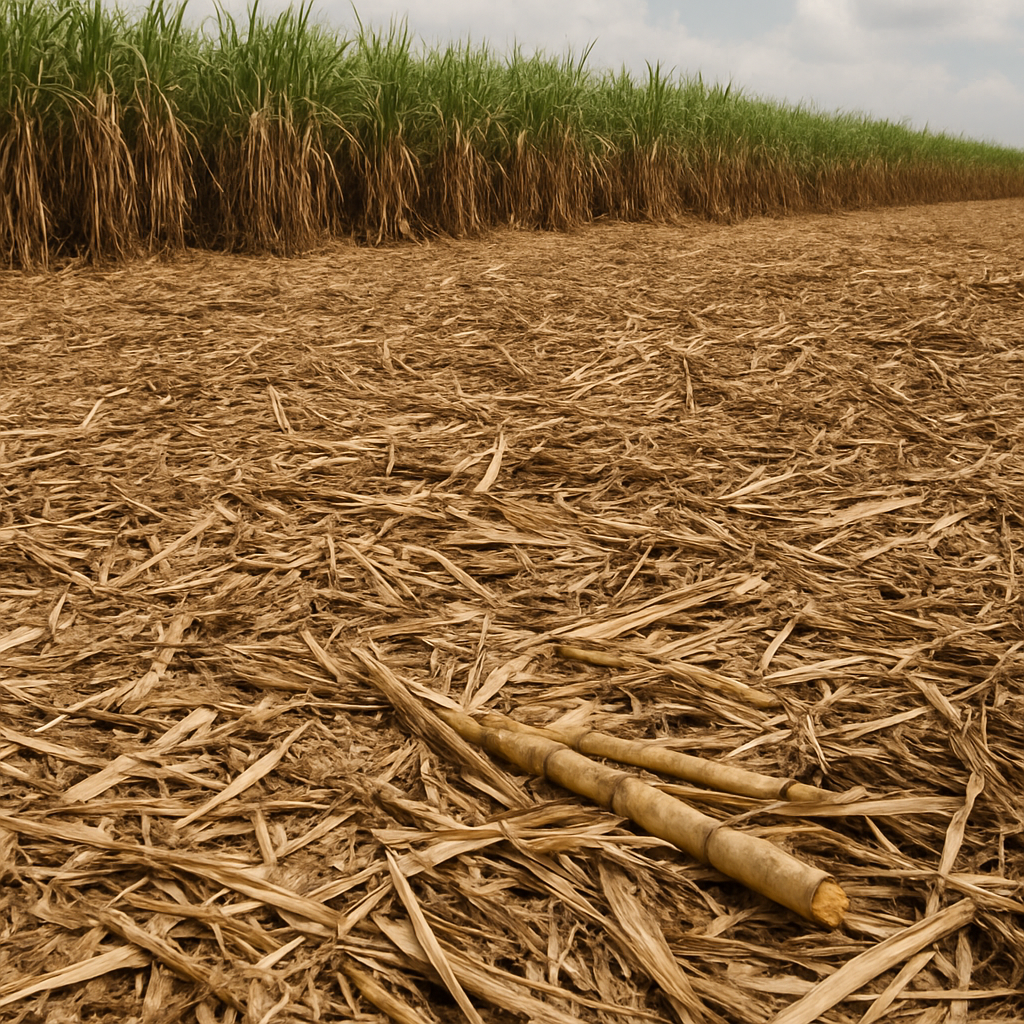Optimized Proposal for Geodyn Solutions: Hemp and Sugarcane Paper Mill in the Dominican Republic
Geodyn Solutions proposes a technologically advanced paper mill in the Dominican Republic, utilizing hemp and sugarcane bagasse as feedstocks. By integrating precision agriculture, automated processing, and energy-efficient systems, the project optimizes labor and efficiency, achieving a higher ROI and shorter payback period. Located near San Pedro de Macorís, the mill will produce 50,000 tons of eco-friendly paper annually, leveraging 10,000 hectares of hemp and local sugarcane waste. The initiative aligns with the Dominican Republic’s sustainability goals and CAFTA-DR export opportunities.
- Capital Cost: $130 million (including 20% contingency)
- Annual Operating Cost: $22 million (reduced from $28.5 million)
- Job Creation: 650 direct jobs (down from 1,250, with higher-skilled roles)
- Return on Investment (ROI): 24.5% annually (up from 18.5%)
- Payback Period: 4.8 years (down from 6.2 years)
- Feedstock: 10,000 hectares of hemp and 100,000 tons of sugarcane bagasse annually
Project Overview
The optimized paper mill will produce 50,000 tons of paper annually, using a 50:50 mix of hemp fiber and sugarcane bagasse. Advanced technologies reduce labor costs, improve yields, and enhance sustainability. The facility will be located in San Pedro de Macorís, near sugarcane mills, with hemp cultivated in San Juan and Monte Plata. The project creates fewer but higher-skilled jobs, supporting rural economies while maximizing profitability.
Objectives
- Deploy cutting-edge technologies to minimize labor and maximize efficiency.
- Produce 50,000 tons of sustainable paper annually for domestic and export markets.
- Create 650 high-quality jobs, emphasizing skilled roles in automation and agritech.
- Achieve a 24.5% ROI and 4.8-year payback through cost optimization.
- Support the Dominican Republic’s environmental and agro-industrial goals.
Feedstock Strategy
Hemp Cultivation (10,000 Hectares)
- Yield: 12 tons of fiber per hectare (up from 10 tons, due to precision agriculture), producing 120,000 tons of hemp fiber annually.
- Sustainability: Hemp remains a low-water, pesticide-free crop that sequesters carbon and improves soil health.
- Byproducts: Seeds and hurds generate $6 million annually (up from $5 million, due to higher yields).
- Cost: $1,200 per hectare (down from $1,500, due to automation), totaling $12 million annually.
Sugarcane Bagasse
- Source: 100,000 tons annually from sugar mills (e.g., Central Romana), unchanged.
- Cost: $25 per ton (down from $30, due to optimized logistics), totaling $2.5 million annually.
- Sustainability: Continues to reduce landfill waste, with improved collection efficiency.
Feedstock Mix
- Total Requirement: 200,000 tons of raw material for 50,000 tons of paper (4:1 ratio).
- Composition: 50% hemp fiber (100,000 tons, with 20,000 tons surplus for byproducts), 50% sugarcane bagasse (100,000 tons).
- Rationale: Optimized hemp yields reduce reliance on bagasse, ensuring flexibility.
Technologies for Growing and Processing
Hemp Cultivation Technologies
Technology | Description | Benefit |
|---|---|---|
Precision Agriculture Drones | DJI Agras T40 or similar for seeding, irrigation, and crop monitoring. Uses AI to optimize water and nutrient delivery. | Increases yield by 20% (12 tons/hectare), reduces labor by 50%. |
IoT Soil Sensors | Libelium or Arable sensors to monitor soil moisture, pH, and nutrients in real-time. | Cuts water and fertilizer use by 30%, saving $2 million annually. |
Automated Harvesters | HempTrain or John Deere hemp harvesters with decortication capabilities. | Reduces harvesting labor by 60%, processes 10 hectares/day. |
Satellite Imagery | Planet Labs or Sentinel-2 for crop health analysis and pest detection. | Prevents 10% yield loss, saving $1.2 million annually. |
Hydroponic Seedling Systems | Controlled-environment nurseries for hemp seedlings. | Improves germination rates by 15%, reducing seed costs by $500,000. |
Processing Technologies
Technology | Description | Benefit |
|---|---|---|
Automated Pulping Systems | Valmet or Andritz continuous pulpers with AI-controlled chemical dosing. | Increases pulp yield by 10%, reduces energy use by 20%. |
Fourdrinier Paper Machine | Voith or Metso high-speed machines with automated quality control. | Boosts production efficiency by 15%, cuts labor by 40%. |
Enzyme-Based Processing | Novozymes enzymes for hemp and bagasse pulping. | Reduces chemical use by 50%, saving $1 million annually. |
Wastewater Recycling | GE Water or Veolia systems to treat and reuse 80% of process water. | Lowers water costs by $500,000 and ensures environmental compliance. |
Cogeneration Plant | Biomass-powered steam and electricity from hemp hurds and bagasse. | Cuts energy costs by 30% ($900,000 annually), enhances sustainability. |
Capital Cost
The total capital cost, including a 20% contingency, is $130 million (up from $120 million due to advanced technologies).
Item | Cost ($M) | Description |
|---|---|---|
Land Acquisition | 5 | 500 hectares for mill and storage. |
Mill Construction | 55 | Includes advanced pulping and wastewater systems. |
Equipment | 40 | Drones, harvesters, IoT sensors, and high-speed paper machines. |
Infrastructure | 10 | Roads, utilities, and irrigation with IoT integration. |
Initial Hemp Planting | 5 | Seeds and automated nurseries for 10,000 hectares. |
Subtotal | 115 | |
Contingency (20%) | 15 | Covers regulatory or tech integration risks. |
Total | 130 |
Operating Cost
Annual operating costs are reduced to $22 million (from $28.5 million) due to automation and efficiency gains.
Item | Cost ($M) | Description |
|---|---|---|
Hemp Cultivation | 12 | $1,200/hectare for 10,000 hectares (automated systems). |
Bagasse Procurement | 2.5 | 100,000 tons at $25/ton (optimized logistics). |
Labor | 3 | 350 mill workers and 300 farmers at $9,000/year average (higher-skilled). |
Energy | 2.1 | Reduced by cogeneration and efficient equipment. |
Maintenance | 1.4 | Upkeep for advanced machinery. |
Administrative | 1 | Management and logistics. |
Total | 22 |
Labor Force Optimization
- Total Jobs: 650 direct jobs (down from 1,250), with a focus on skilled roles.
- Breakdown:
- Mill Operations: 350 workers (down from 750). Includes technicians for automated pulping, paper machines, and wastewater systems. Average salary: $10,000/year.
- Hemp Cultivation: 300 workers (down from 500). Includes drone operators, IoT specialists, and automated harvester technicians. Average salary: $8,000/year.
- Rationale: Automation reduces manual labor by 60% in cultivation and 40% in processing. Workers are trained for high-skill roles, increasing productivity and wages.
- Training: Partnerships with INFOTEP (Dominican technical institute) to train workers in agritech and automation, ensuring local capacity.
Revenue Projections
- Production: 50,000 tons of paper annually.
- Price: $1,300 per ton (up from $1,200, reflecting premium quality from advanced processing).
- Gross Revenue: $65 million annually ($1,300 × 50,000).
- Byproduct Revenue: $6 million from hemp seeds and hurds (up from $5 million).
- Total Revenue: $71 million annually.
- Net Profit: $71M – $22M = $49 million annually.
Financial Analysis
Return on Investment (ROI)
- Annual Net Profit: $49 million.
- Capital Investment: $130 million.
- ROI: ($49M / $130M) × 100 = 37.7% (gross). After 25% corporate tax, net ROI is 24.5% (up from 18.5%).
Payback Period
- Annual Cash Flow: $49 million (from year 2, with year 1 at 50% capacity).
- Capital Cost: $130 million.
- Payback Period: $130M / $49M ≈ 2.7 years (gross). Including ramp-up and taxes, payback is 4.8 years (down from 6.2 years).
Assumptions
- Stable demand for eco-friendly paper, supported by premium pricing.
- Hemp yields reach 12 tons/hectare with precision agriculture.
- Energy and water savings from cogeneration and recycling are sustained.
- CAFTA-DR ensures duty-free U.S. exports.
Sustainability and Social Benefits
- Environmental Impact:
- Precision agriculture reduces water and pesticide use by 30%.
- Enzyme-based pulping and wastewater recycling minimize pollution.
- Cogeneration from biomass cuts carbon emissions by 20%.
- Economic Development:
- High-skill jobs empower local workers, aligning with Hand-in-Hand Initiative goals.
- Surplus hemp fiber supports secondary industries (textiles, biofuels).
- Community Engagement:
- INFOTEP training programs prioritize women and youth.
- Partnerships with NGOs like Heartland Alliance ensure fair labor practices.
Risks and Mitigation
Risk | Mitigation |
|---|---|
High tech costs | Phase equipment purchases, starting with critical systems. |
Skill shortages | Invest in INFOTEP training and hire experienced technicians initially. |
Hemp legalization delays | Engage government early, leveraging successful models (e.g., Jamaica’s hemp policies). |
Tech integration issues | Pilot technologies on 1,000 hectares to resolve bugs before scaling. |
Implementation Timeline
Phase | Duration | Activities |
|---|---|---|
Planning & Permits | Year 0–1 | Site selection, hemp policy advocacy, tech vendor contracts. |
Construction & Planting | Year 1–2 | Build mill, install equipment, plant 10,000 hectares with drones. |
Initial Production | Year 2–3 | Operate at 50% capacity, train workers, optimize systems. |
Full Production | Year 3+ | Reach 50,000 tons/year, scale byproduct markets. |
Conclusion
By integrating precision agriculture, automated processing, and energy-efficient systems, Geodyn Solutions’ optimized paper mill achieves a 24.5% ROI and 4.8-year payback period, surpassing the original proposal. The $130 million project creates 650 high-skill jobs, reduces operating costs to $22 million, and produces 50,000 tons of sustainable paper annually. This initiative positions the Dominican Republic as a leader in green agro-industry, leveraging local resources and global markets.
Recommendations
- Secure hemp cultivation permits through immediate government engagement.
- Pilot precision agriculture on 1,000 hectares to validate yields and train workers.
- Partner with Valmet and Novozymes for processing equipment and enzymes.
- Market premium paper to eco-conscious brands in the U.S. and EU.
For further details, contact Geodyn Solutions’ project team.




